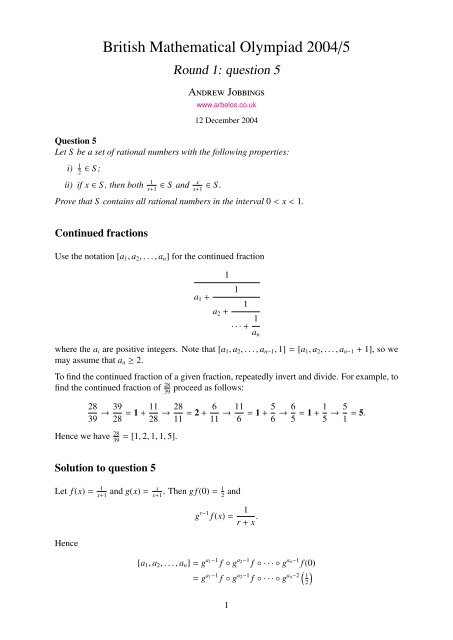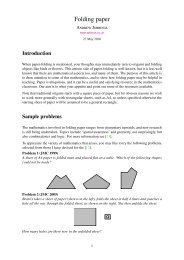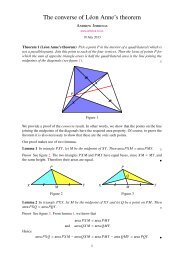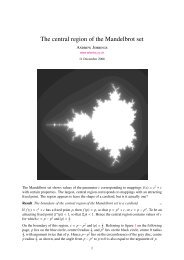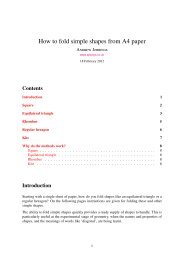British Mathematical Olympiad 2004/5 - Arbelos
British Mathematical Olympiad 2004/5 - Arbelos
British Mathematical Olympiad 2004/5 - Arbelos
Create successful ePaper yourself
Turn your PDF publications into a flip-book with our unique Google optimized e-Paper software.
<strong>British</strong> <strong>Mathematical</strong> <strong>Olympiad</strong> <strong>2004</strong>/5<br />
Round 1: question 5<br />
Andrew Jobbings<br />
www.arbelos.co.uk<br />
12 December <strong>2004</strong><br />
Question 5<br />
Let S be a set of rational numbers with the following properties:<br />
i) 1 2 ∈ S ;<br />
ii) if x ∈ S , then both 1<br />
x+1 ∈ S and x<br />
x+1 ∈ S .<br />
Prove that S contains all rational numbers in the interval 0 < x < 1.<br />
Continued fractions<br />
Use the notation [a 1 , a 2 , . . . , a n ] for the continued fraction<br />
a 1 +<br />
1<br />
a 2 +<br />
1<br />
1<br />
· · · + 1 a n<br />
where the a i are positive integers. Note that [a 1 , a 2 , . . . , a n−1 , 1] = [a 1 , a 2 , . . . , a n−1 + 1], so we<br />
may assume that a n ≥ 2.<br />
To find the continued fraction of a given fraction, repeatedly invert and divide. For example, to<br />
find the continued fraction of 28 proceed as follows:<br />
39<br />
28<br />
39 → 39<br />
28 = 1 + 11<br />
28 → 28<br />
11 = 2 + 6<br />
11 → 11 6 = 1 + 5 6 → 6 5 = 1 + 1 5 → 5 1 = 5.<br />
Hence we have 28<br />
39<br />
= [1, 2, 1, 1, 5].<br />
Solution to question 5<br />
Let f (x) = 1<br />
x<br />
and g(x) = . Then g f (0) = 1 and<br />
x+1 x+1 2<br />
Hence<br />
g r−1 f (x) = 1<br />
r + x .<br />
[a 1 , a 2 , . . . , a n ] = g a1−1 f ◦ g a2−1 f ◦ · · · ◦ g an−1 f (0)<br />
= g a1−1 f ◦ g a2−1 f ◦ · · · ◦ g ( )<br />
a n−2 1<br />
2<br />
1
www.arbelos.co.uk/papers.html c○ Andrew Jobbings <strong>2004</strong><br />
which gives a closed form for [a 1 , a 2 , . . . , a n ] in terms of f and g.<br />
It follows that any rational number in the interval 0 < x < 1 belongs to S , since any such<br />
rational may be expressed as a continued fraction of the form [a 1 , a 2 , . . . , a n ].<br />
Example<br />
For example,<br />
giving the sequence of fractions<br />
1<br />
2<br />
g<br />
↦−→ 1 3<br />
g<br />
↦−→ 1 4<br />
28<br />
39<br />
g<br />
↦−→ 1 5<br />
= [1, 2, 1, 1, 5]<br />
= f ◦ g f ◦ f ◦ f ◦ g ( )<br />
3 1<br />
2<br />
f<br />
↦−→ 5 6<br />
f<br />
↦−→ 6 11<br />
f<br />
↦−→ 11<br />
17<br />
g<br />
↦−→ 11<br />
28<br />
f<br />
↦−→ 28<br />
39 .<br />
2


